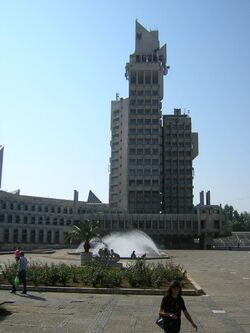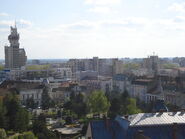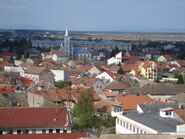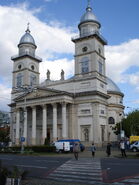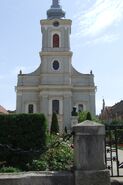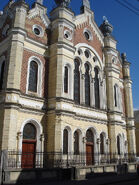| Main | Births etc |
|---|
| Satu Mare Hungarian: Szatmárnémeti German: Sathmar |
|||
|---|---|---|---|
| — City — | |||
| Satu Mare City Hall | |||
|
|||
| Location of Satu Mare | |||
| Coordinates: Coordinates: | |||
| Country | |||
| County | |||
| Status | County capital | ||
| Founded | 972 (first official record as Villa Zotmar) | ||
| Component villages | Sătmărel | ||
| Government | |||
| • Mayor | Iuliu Ilyés (UDMR) | ||
| • Deputy Mayor | Adrian Albu (PNL) | ||
| • Deputy Mayor | Gábor Kereskényi (UDMR) | ||
| Area | |||
| • Total | 150.3 km2 (58.0 sq mi) | ||
| Population (July 1, 2007[1]) | |||
| • Total | 113,688 | ||
| • Density | 756/km2 (1,960/sq mi) | ||
| Time zone | EET (UTC+2) | ||
| • Summer (DST) | EEST (UTC+3) | ||
| Postal Code | 44xyz | ||
| Area code(s) | +40 x61 | ||
| Twin cities | |||
| • Berehove | |||
| • Nyíregyháza | |||
| • Rzeszów | |||
| • Schwaz | |||
| • Uzhhorod | |||
| • Wolfenbüttel | |||
| • Zutphen | |||
| Car Plates | SM | ||
| Website | http://www.satu-mare.ro | ||
Satu Mare (Hungarian: Szatmárnémeti German: Sathmar) is a city with a population of 113,688 and the capital of Satu Mare County, Romania. The city is an important academic, cultural, industrial and business centre in northwestern Romania.
Geography[]
Satu Mare is situated in Satu Mare County, in northwest Romania, on the Someş River, 13 kilometres (8.1 mi) from the border with Hungary and 27 kilometres (17 mi) from the border with Ukraine. The city is located at an altitude of 126 metres (413 ft) on the Lower Someş alluvial plain. From a geomorphologic point of view, the city is located on the Someş Meadow on both sides of the river, which narrows in the vicinity of the city and widens upstream and downstream from it; flooded during heavy rainfall, the field has various geographical configurations at the edge of the city (sand banks, valleys, micro-depressions).[2] The formation of the current terrain of the city, dating from the late Pliocene in the Tertiary period, is linked to the clogging of the Pannonian Sea. Layers of soil were created from deposits of sand, loess and gravel, and generally have a thickness of 16 metres (52 ft)–18 metres (59 ft). Over this base, decaying vegetation gave rise to podsolic soils, which led to favorable conditions for crops (cereals, vegetables, fruit trees).[2] The water network around Satu Mare is composed of the Someş River, Pârâul Sar in the north and the Homorod River in the south. The formation and evolution of the city was closely related to the Someş River, which, in addition to allowing for the settlement of a human community around it, has offered, since the early Middle Ages, the possibility of international trade with coastal regions, a practice that favored milling, fishing and other economic activities.[2] Because the land slopes gently around the city, the Someş River has created numerous branches and meanders (before 1777, in the perimeter of the city there were 25 meanders downstream and 14 upstream). After systematisation works in 1777, the number of meanders in the city dropped to 9 downstream and 5 upstream, the total length of the river now being at 36.5 kilometres (22.7 mi) within the city. Systematisation performed up to the mid-19th century configured the existing Someş riverbed; embankments were built 17.3 kilometres (10.7 mi) long on the right bank and 11 kilometres (6.8 mi) on the left. In 1970, the embankments were raised by 2 metres (6.6 ft)–3 metres (9.8 ft), protecting 52,000 hectares within the city limits and restoring nearly 800 ha of agricultural land that had previously been flooded.[2] The city's largest park, the Garden of Rome, features some rare trees that are uncommon to the area, including Styphnolobium japonicum, native to East Asia (especially China); Pterocarya, also native to Asia; and Paulownia tomentosa, native to central and western China.[2]
Flora and fauna[]
The flora associated with the town of Satu Mare is characteristic for the meadow area with trees of soft essence like wicker, indigenous poplar, maple and hazelnut. Grassland vegetation is represented by Agrostis stolonifera, Poa trivialis, Alopecurus pratensis and other types of vegetation.[2] Fauna is represented by species of rodents (hamster and european ground squirrel), reptiles, including Vipera berus in the Noroieni forest, and as avifauna species of ducks, geese, egrets, during passages and systematic occasional wanderings.[2]
Climate[]
Satu Mare has a continental climate, characterised by hot dry summers and cold winters. As the city is in the far north of the country, winter is much more colder than the national average, with an average temperature of −17 °C (1 °F), lower than values recorded in other cities in western Romania like Oradea (−15 °C (5 °F)) or Timişoara (−17 °C (1 °F)). The average annual temperature is 9.6 °C (49 °F), or broken down by seasons: Spring 10.2 °C (50 °F), Summer 19.6 °C (67 °F), Autumn 10.8 °C (51 °F) and Winter 1.7 °C (35 °F).[2] Atmospheric humidity is quite high. Prevailing wind currents blow in from the northwest, bringing spring and summer rainfall.
| Climate data for Satu Mare | |||||||||||||
|---|---|---|---|---|---|---|---|---|---|---|---|---|---|
| Month | Jan | Feb | Mar | Apr | May | Jun | Jul | Aug | Sep | Oct | Nov | Dec | Year |
| Average high °C (°F) | 1 (34) |
3 (37) |
10 (50) |
15 (59) |
20 (68) |
22 (72) |
25 (77) |
25 (77) |
21 (70) |
15 (59) |
7 (45) |
2 (36) |
13 (55) |
| Average low °C (°F) | −5 (23) |
−3 (27) |
1 (34) |
5 (41) |
9 (48) |
12 (54) |
13 (55) |
13 (55) |
10 (50) |
5 (41) |
0 (32) |
−2 (28) |
5 (41) |
| Precipitation cm (inches) | 2 (0.8) |
2 (0.8) |
2 (0.8) |
4 (1.6) |
7 (2.8) |
8 (3.1) |
8 (3.1) |
7 (2.8) |
4 (1.6) |
4 (1.6) |
3 (1.2) |
2 (0.8) |
59 (23.2) |
| Source: weatherbase.com[3] | |||||||||||||
Etymology[]
The origin of the name of the town is Hungarian. The Hungarian name Szatmár comes from an old Hungarian personal name, Zotmar. Until 1925, in Romanian, the name Sătmar was used, which is the Hungarian name transcribed to Romanian orthography. Since 1925, the name of the town in Romanian is officially Satu Mare, which is similar in pronunciation to the original name, but also conveys meaning in Romanian, namely "the great village".[4]
History[]

Dacia Hotel
Archaeological evidence from Ţara Oaşului, Ardud, Medieşu Aurit, Homoroade, etc. clearly shows settlements in the area dating to the Stone Age and the Bronze Age. There is also evidence that the local Dacian population remained there after the Roman conquest in 101/106 AD. Later, these lands formed part of Menumorut's holdings; one of the defensive citadels dating to the 10th century was at Satu Mare (Castrum Zotmar), as mentioned in the Gesta Hungarorum. The city centre, Villa Zotmar, was inhabited by natives, but Teutonic colonists settled on the periphery, brought there in 972[5] by Queen Gisela of Hungary; later, they were joined by German colonists from beyond the Someş River, in Mintiu.[6] In 1543, the Báthory family took possession of the citadel, proceeding to divert the Someş' waters in order to defend the southern part of the citadel; thus, the fortress remained on an island linked to the main roads by three bridges over the Someş. In 1562 the citadel was besieged by Ottoman armies led by Pargalı İbrahim Pasha of Buda and pasha Maleoci of Timişoara. Then the Habsburgs besieged it, leading the fleeing Transylvanian armies to set it on fire. The Austrian general Lazar Schwendi ordered the citadel to be rebuilt after the plans of Italian architect Ottavio Baldigara; using an Italian system of fortifications, the new structure would be pentagonal with five towers. In the Middle Ages, Satu Mare and Mintiu were two distinct entities, but between 1712 and 1715 the two gradually united their administration. On 2 January 1721 Emperor Charles VI recognised the union, at the same time granting Satu Mare the status of free royal city.[6] A decade earlier, the Treaty of Szatmár was signed in the city, ending Rákóczi's War for Independence.[7]
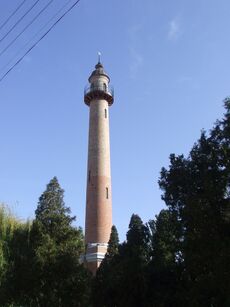
Firemen's Tower
Due to the economic and commercial benefits it began to receive in the 13th century, Satu Mare became an important centre for craft guilds. In the 18th century, intense urbanisation began; several buildings survive from that period, including the old city hall, the inn, a barracks, the Greek Catholic church and the Reformed church. A Roman Catholic diocese was established there in 1804. In 1823, the city's systematization commission was established in order to direct its local government. In 1844, paving operations begun in 1805 were stepped up. The first industrial concerns also opened, including the steam mill, the brick factory, the Neuschloss Factory for wood products, the lumber factory, the Princz Factory and the Unio Factory. Due to its location at the intersection of commercial roads, Satu Mare (then called Szatmárnémeti) became and important rail hub. The Satu Mare–Carei line was built in 1871, followed in 1872 by the Satu Mare–Sighetu Marmaţiei line, an 1894 link to Baia Mare, 1900 to Ardud and 1906 to Bixad.[6]
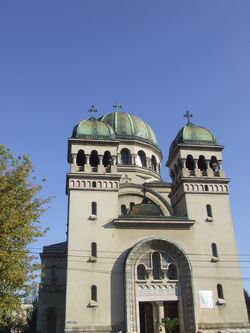
SS. Michael and Gabriel Cathedral
Since the second half of the 19th century, it underwent important economic and socio-cultural changes. The city's large companies (the Unio wagon factory, the Princz Factory, the Ardeleana textile enterprise, the Freund petroleum refinery, the brick factory and the furniture factory) prospered in this period, and the city invested heavily in communication lines, schools, hospitals, public works and public parks. The banking and commerce system also developed: in 1929 the Chamber of Commerce and Industry, as well as the commodities stock market were established, with 25 commercial enterprises and 75 industrial and production firms as members. In 1930 there were 33 banks.[6] After the collapse of Austria-Hungary, Romanian troops captured the town during their offensive launched on April 15, 1919.[8] The Treaty of Trianon recognised the Union of Transylvania with Romania and Satu Mare officially ceased to be part of Hungary becoming part of the Romania. In 1940, the Second Vienna Award gave back Northern Transylvania, including Satu Mare, to Hungary. During World War II, its then considerable Jewish population suffered persecution as part of The Holocaust.[9] In October 1944, the city was captured by the Soviet Red Army. After 1945, the city became again part of Romania. Soon afterwards, a Communist regime came to power, lasting until the 1989 revolution.[6]
Jewish community[]
Among the notable Jews of the local Jewish community have been historian Ignác Acsády, parliamentary deputies Ferenc Corin and Kelemen Samu, politician Oszkár Jászi, writers Gyula Csehi, Rodion Markovits, Sándor Dénes and Ernő Szép, painter Pál Erdös, and director György Harag.[10] The Jewish community in Satu Mare traces its origins to 1623, when the prince of Transylvania, Gabriel Bethlen, brought Jews there and permitted them to settle in the city. The first Jewish community organisation was established in 1842 and in 1858 the first synagogue was built in the city.[10] On the site of the first synagogue, in 1893 the Decebal Street Synagogue was built.[11] The largest Jewish presence was recorded in 1910, when 29,468 Jews were recorded in the city.[10] In 1944, the Jewish population was deported to the territory of Nazi Germany as a part of The Holocaust. Six trains left for Auschwitz-Birkenau on May 19, 1944, carrying approximately 3300 persons. In total, 18,863 Jews were deported from Satu Mare and among them 14,440 Jews were killed. The survivors who returned mainly emigrated to Israel.[12] The 2002 census numbered 30 Jews in the city;[13] in 2004, a Holocaust memorial was dedicated in the Decebal Street Synagogue's courtyard. Aside from the synagogues, two Jewish cemeteries also remain.[10]
Demographics[]
| Historical population of Satu Mare | |||||||||||||
| Year | Population | Romanians | Hungarians | ||||||||||
|---|---|---|---|---|---|---|---|---|---|---|---|---|---|
| 1880 | 7.9% | 83.1% | |||||||||||
| 1890 | 8.1% | 89.9% | |||||||||||
| 1900 | 7.8% | 89.01% | |||||||||||
| 1910 | 6.3% | 91.4% | |||||||||||
| 1920 | 15.2% | 63.6% | |||||||||||
| 1930 | 28.9% | 57.1% | |||||||||||
| 1941 | 6.6% | 90.2% | |||||||||||
| 1956 | 36.5% | 58.2% | |||||||||||
| 1966 | 44.2% | 54.9% | |||||||||||
| 1977 | 51.04% | 47.2% | |||||||||||
| 1992 | 55.8% | 43.2% | |||||||||||
| 2002 | 57.9% | 39.3% | |||||||||||
| 2007 | n/a | n/a | |||||||||||
|
Source (if not otherwise specified): | |||||||||||||
According to the last census, conducted on 31 May 2002, the population of Satu Mare was 115,142,[15] making it the 19th largest city in Romania. The historic changes in population is shown in the side table. The ethnic makeup is as follows:[16]
- Romanians: 66,638 (57.9%)
- Hungarians: 45,287 (39.3%)
- Roma: 1,115 (0.9%)
- German: 1,110 (0.9%)
- Swabians: 487 (0.4%)
- Ukrainians: 271 (0.2%)
- Others: 0.4%
As of 2007, Satu Mare has an estimated population of 113,668. The city day is May 14, which commemorates the devastating floods that affected the city in 1970, although it is also a day of rebirth. Template:SatuMare/Demographics No religious group can claim a majority in Satu Mare, but there is a plurality of Romanian Orthodox believers (48.59%). Other important communities are Roman Catholic (19.79%), Hungarian Reformed (19.51%), and Eastern Catholic (8.41%).[17] Satu Mare is the origin of the Satmarer Hasidic Jews, who lived there until World War II and now reside in New York City, Jerusalem, London, and other places.[18][19]
Politics[]
Administration[]
The city government is headed by a mayor. From 2004, the office is held by Iuliu Ilyés,[20] who was re-elected in 2008. Decisions are approved and discussed by the local council (consiliu local) made up of 23 elected councillors.[21] The city is divided into 12 districts (cartiere) laid out radially.[22] One of these, Sătmărel, is a separate village administered by the city.[23]
|
|
Additionally, as Satu Mare is the capital of Satu Mare County, the city hosts the palace of the prefecture, the headquarters of the county council (consiliu judeţean) and the prefect, who is appointed by Romania's central government. The prefect is not allowed to be a member of a political party, and his role is to represent the national government at the local level, acting as a liaison and facilitating the implementation of National Development Plans and governing programmes at the local level. The current prefect of Satu Mare County (as of 2008) is Giurca Radu.[24] Like all other local councils in Romania, the Satu Mare local council, the county council and the city's mayor are elected every four years by the population.[25] The Satu Mare Municipal Council, elected in the 2008 local government elections, is composed of the following parties:
| Party | Seats in 2008 | Current Council | |||||||||||
|---|---|---|---|---|---|---|---|---|---|---|---|---|---|
| Democratic Union of Hungarians in Romania | 11 | ||||||||||||
| Social Democratic Party | 5 | ||||||||||||
| Democratic Liberal Party | 4 | ||||||||||||
| National Liberal Party | 3 | ||||||||||||
Justice system[]
Satu Mare has a complex judicial organisation, as a consequence of its status of county capital. The Satu Mare Court of Justice is the local judicial institution and is under the purview of the Satu Mare County Tribunal, which also exerts its jurisdiction over the courts of Carei, Ardud, Negreşti-Oaş, Tăşnad and Livada.[26] Appeals from these tribunals' verdicts, and more serious cases, are directed to the Satu Mare Court of Appeals. The city also hosts the county's commercial and military tribunals.[26] Satu Mare has its own municipal police force, Poliţia Municipiului Satu Mare, which is responsible for policing of crime within the whole city, and operates a number of special divisions. The Satu Mare Police are headquartered on Mihai Viteazul Street in the city centre (with a number of precincts throughout the city) and it is subordinated to the County's Police Inspectorate on Alexandru Iioan Cuza Street.[27] City Hall has its own community police force, Poliţia Comunitară located on Universului Alley, dealing with local community issues. Satu Mare also houses the County's Gendarmerie Inspectorate.
Transport[]
Road[]
Satu Mare has a complex system of transportation, providing road, air and rail connections to major cities in Romania and Europe. The city is an important road and rail hub located near the borders with Hungary and Ukraine. The city is connected to other major Romanian cities by road (![]() European route E81,
European route E81, ![]() European route E671 and
European route E671 and ![]() European route E58) and by rail (CFR Main Line 400). The total number of automobiles registered in Satu Mare was 82,000 in 2008.[28] The city has around 400 streets with a total length of 178 kilometres (111 mi) and cover an area of 1.3 square kilometres (0.50 sq mi).
European route E58) and by rail (CFR Main Line 400). The total number of automobiles registered in Satu Mare was 82,000 in 2008.[28] The city has around 400 streets with a total length of 178 kilometres (111 mi) and cover an area of 1.3 square kilometres (0.50 sq mi).
Railway[]
Satu Mare Rail Station, located about 2 kilometres (1.2 mi) north of the city centre, is situated on the Căile Ferate Române Line 400 (Braşov - Siculeni – Deda – Dej – Baia Mare),[29] on Line 402 (Oradea - Săcueni - Carei - Satu Mare - Halmeu)[29] and on Line 417 (Satu Mare - Bixad).[29] CFR provides direct rail connections to all the major Romanian cities and to Budapest.[29] The city is also served by another secondary rail station, the Saw Station (Gara Ferăstrău).[29]
Public transport[]
The main public transportation system in Satu Mare consists of bus lines. There are twenty-three urban and suburban lines with a total length of 190.1 kilometres (118.1 mi), the main operator being Transurban S.A.[30] In addition, there are various taxi companies serving the city.
Airport[]
The city is served by the Satu Mare International Airport (IATA: SUJ, ICAO: LRSM), located 13 kilometres (8.1 mi) south of the city, with a concrete runway, one of the longest in Romania, and the only operator is TAROM with regular flights to Oradea and Bucharest.[31][32]
Sports[]
Football (soccer) is the most popular recreational sport in Satu Mare. There are two major football clubs in Satu Mare: Olimpia and Someşul, with Olimpia playing in the Romanian Liga III in the 2009/2010 season and Someşul playing in the Liga IV.[33] There are two football stadiums in Satu Mare: Stadionul Olimpia with 18,000 seats[34] and Someşul Stadium with 3,000 seats. Other popular recreational activities include fencing, handball, bowling, women's basketball, karate and chess. The local women's basketball team CSM Satu Mare is one of the best in the Romanian league; it finished third in the 2008/2009 season playoffs.[35] The team plays its home matches in the largest indoor arena in the city, the LPS Arena, which has a capacity of 400 seats.[34] The Cypriot professional tennis player Marcos Baghdatis was brought to Satu Mare in 1998 for a month and a half by his former coach Jean Dobrescu[36] to train and to participate in local tennis competitions alongside his fellow Davis Cup team member, Rareş Cuzdriorean,[37] who is also a Satu Mare native with Cypriot citizenship.[38]
Fencing[]
Satu Mare has a tradition in fencing dating to 1885, and is the city that has supplied the most world and Olympic champions in Europe. Names like Ecaterina Stahl, Marcela Moldovan, Suzana and Ştefan Ardeleanu, Petru Kuki, Rudolf Luczki, Samuilă Melczhner, Geza Tere and in particular Alexandru Csipler figure prominently in the annals of Romanian fencing. The last four also formed the core of the city's fencing school, winning major local and international tournaments. Top results for which there is evidence date to 1935, when the local foil team, Olimpia Satu Mare, lost against CFR Timişoara by a score of 15-10 in the national final, while Rudolf Luczki won the sabre finals held in Cluj-Napoca. In 1973, the first signaling device in Romania was used in Satu Mare; this has been characterised as "a veritable revolution" for Romanian fencing.[39]
Economy[]
Satu Mare benefits from its proximity to the borders with Hungary and Ukraine, which makes it a prime location for logistical and industrial parks. Companies that have established production facilities in Satu Mare are Voestalpine, Dräxlmaier Group,[40] Gotec Group,[41] Anvis Group,[42] Schlemmer, Casco Schützhelme and Zollner Elektronik[43][44] in the industrial sector; FrieslandCampina in the food sector; Radici Group in the textile sector; and Saint-Gobain and Boissigny in the wood industry. Currently the largest private employer in Satu Mare is the German automotive company Dräxlmaier Group which owns since 1998 an electric engine components factory in the city and has around 3,600 employees. The factory supplies automotive wiring especially to the German car manufacturer Daimler AG but it also supplied wiring to another car manufacturer Porsche for its Porsche Panamera model.[45] The Swedish company Electrolux owns a kitchen stove factory in the city acquired in 1997, that has a surface area of 52,000 square metres (560,000 sq ft) and 1,800 employees. The facility has an annual production capacity of around 1.2 million units and the majority of the Zanussi brand kitchen stoves in Europe are manufactured there.[46][47] The Austrian company Voestalpine owns, since 2004, a steel tubes production facility with an annual capacity of 50 million units per year.[48] The German company Arcandor has its main Romanian office established in Satu Mare. The subsidiary, accounting for the region formed by Romania and Hungary, is the most important amongst the 16 subsidiaries in Europe in terms of the percentage of sales through online orders having in 2008 total orders of €19.3 million. The company also owns a 40,000 square metres (430,000 sq ft) logistic facility and a call center in the city.[49] Satu Mare's retail sector is fairly well-developed; a number of international companies such as Real,[50] Kaufland,[51] Billa,[52] Plus,[53] Metro Point[54] and Interex have supermarkets or hypermarkets in the city. There is also a DIY store, a Praktiker,[55] and several small malls: Grand Mall of 6,000 square metres (65,000 sq ft),[56] Plaza Europa of 3,000 square metres (32,000 sq ft)[57] and the largest, Someşul Mall, of 13,000 square metres (140,000 sq ft).[58] There is also an industrial park called Satu Mare Industrial Park located at the edge of the city on a 70 ha surface.
Tourism[]
Major tourists attractions are:
- the Firemen's Tower, a 47 metres (154 ft) tall tower
- the Roman Catholic Cathedral
- the Capitoline Wolf statue
- the Chain Church
- the Administrative Palace, a 97 metres (318 ft) tall building
- the Dacia Hotel
- the Garden of Rome
The city spreads out from the Administrative Palace at 25 October Square, one of the tallest buildings in Romania.[59] The boundaries of the municipality contain an area of 150.3 square kilometres (58.0 sq mi). There are several hotels in the city: two 4-star hotels – Hotel Poesis and Villa Bodi; eleven 3-star hotels – Astoria, Leon, Villa Lux, Dacia, Aurora, Dana I, Dana II, Select, Rania, Melody and Belvedere; and one 2-star hotel – Sport.
Education[]
Universities[]
Satu Mare is home to the Commercial Academy of Satu Mare[60] and several other branches of important Romanian universities:
- Babeş-Bolyai University[60]
- Spiru Haret University[60]
- Technical University of Cluj-Napoca[60]
- University of Oradea[61]
- Vasile Goldiş West University of Arad[60]
High schools[]
Satu Mare has 16 high schools, of which four are national colleges:[62]
- Doamna Stanca National College[62]
- Ioan Slavici National College[62]
- Kölcsey Ferenc National College[62]
- Mihai Eminescu National College[62]
Gymnasiums[]
The city has 16 gymnasiums[63] with the most important being:
- Grigore Moisil Gymnasium[63]
- The Ion Creangă Gymnasium Satu Mare[63] (Romanian: Şcoala Generală Ion Creangă) is a gymnasium in Satu Mare. It was founded in 1990 and is named after the Romanian writer, storyteller and memoirist Ion Creangă.[64]
- Lucian Blaga Gymnasium[63]
Media[]
Newspapers[]
- Informaţia Zilei – daily local newspaper[65]
- Gazeta de Nord-Vest – daily local newspaper[66]
- Cronica Sătmăreană – daily local newspaper
- Friss Újság – daily local newspaper in Hungarian language[67]
- Szatmári Magyar Hírlapp – daily local newspaper in Hungarian language[68]
TV Stations[]
- TV1 Samtel
- Nord Vest TV
- Pro TV Satu Mare
Radio Stations[]
- Radio City Satu Mare
- Radio Unu
- Radio Transilvania
- Kiss FM Satu Mare
Online portal[]
- Satu Mare Online
Consulates[]
Natives[]
Twin towns — Sister cities[]
Satu Mare is twinned with:
Schwaz, Austria, since 2007[70]
 Wolfenbüttel, Germany, since 1974[71]
Wolfenbüttel, Germany, since 1974[71]Nyíregyháza, Hungary, since 2000[72]
Zutphen, Netherlands, since 1970[73]
Rzeszów, Poland, since 2007[74][75]
 Berehove, Ukraine, since 2007[76]
Berehove, Ukraine, since 2007[76] Uzhhorod, Ukraine, since 2006[77]
Uzhhorod, Ukraine, since 2006[77]
Gallery[]
See also[]
- Satmar (Hasidic dynasty)
- List of companies based in Satu Mare
- List of natives and inhabitants of Satu Mare
References[]
Notes[]
- ^ Population of Romania as of July 1, 2007
- ^ a b c d e f g h "Geografie" (in Romanian). www.satu-mare.ro. http://www.satu-mare.ro/despre/localizare.html. Retrieved 2009-06-22.
- ^ "Weatherbase data for Satu Mare". http://www.weatherbase.com/weather/weatherall.php3?s=1051&refer=&units=metric. Retrieved 2009-06-22.
- ^ (Romanian) Leontina Volosciuc, "Satu Mare: Oraş cu nume de sat şi sat cu nume de oraş" ("Satu Mare: A City with the Name of a Village and a Village with the Name of a City"), Adevărul, 23 September 2010; accessed February 17, 2011
- ^ "Date Istorice" (in Romanian). Inspectoratul Şcolar Judeţean. http://www.isj.sm.edu.ro/isj/index.php?option=com_content&task=view&id=14. Retrieved 2009-06-14.
- ^ a b c d e "History of Satu Mare City". Satu Mare City Hall. http://www.satu-mare.ro/despre/istorie.html.en. Retrieved 2008-08-02.
- ^ Wandycz, Piotr Stefan. The Price of Freedom: A History of East Central Europe from the Middle Ages to the Present, p.85. Routledge, 2001, ISBN 0415254914
- ^ Béla Köpeczi (editor). "History of Transylvania". Atlantic Research and Publications, Inc.. http://mek.niif.hu/03400/03407/html/440.html. Retrieved 2010-08-18.ISBN 0-88033-497-5
- ^ Ynet הרב'ה אמר: תישארו באירופה - יהדות
- ^ a b c d "History". www.jewishcomunity.ro. http://www.jewishcomunity.ro/en/index.php?page=content&p=1. Retrieved 2009-06-14.
- ^ "Satu Mare Synagogue" (in Romanian). /www.satu-mare.ro. 2009-06-05. http://www.satu-mare.ro/biserici/sinagoga.html.ro. Retrieved 2009-06-05.
- ^ "Let's not forget". www.jewishcomunity.ro. http://www.jewishcomunity.ro/en/index.php?page=content&p=3. Retrieved 2009-06-14.
- ^ (Romanian) Census results
- ^ "Etnikai statisztikák" (in Hungarian). Árpád E. Varga. http://varga.adatbank.transindex.ro/?pg=3&action=etnik&id=2125. Retrieved 2009-06-13.
- ^ "Rezultate" (in Romanian). Institutul Naţional de Statistică. 2002. http://www.recensamant.ro/pagini/rezultate.html. Retrieved 2008-07-20.
- ^ "Demografie" (in Romanian). www.satu-mare.ro. http://www.satu-mare.ro/despre/demografie.html. Retrieved 2009-06-28.
- ^ "Structura populaţiei dupā religie" (in Romanian). http://www.edrc.ro/. http://www.edrc.ro/recensamant.jsp?regiune_id=2140&judet_id=2447&localitate_id=2448. Retrieved 2009-09-29.
- ^ Nathan, Joan (2006-12-13). "From Hungary, For Hanukkah, From Long Ago". The New York Times. The New York Times Company. http://query.nytimes.com/gst/fullpage.html?res=9C03E4DE1531F930A25751C1A9609C8B63&scp=1&sq=Satmar+Szatmarnemeti&st=nyt. Retrieved 2008-06-25.
- ^ Chris McKenna, "Satmar Grand Rebbe Moses Teitelbaum dies", Record Online, 25 April 2006
- ^ "Primarul municipiului Satu Mare" (in Romanian). www.satu-mare.ro. 2009-06-13. http://www.satu-mare.ro/persoane/ilyes.html. Retrieved 2009-06-13.
- ^ "Membri consiliul local" (in Romanian). www.satu-mare.ro. http://www.satu-mare.ro/consiliul/consilieri/. Retrieved 2009-06-13.
- ^ "Districts of Satu Mare" (in Romanian). Transurban. 2009-06-13. http://www.transurbansatumare.ro/trans/harta_trasee.html. Retrieved 2009-06-13.
- ^ "Urbanism, Satu Mare" (in Romanian). Satu Mare County Council. http://www.cjsm.ro/meniu-satumare-M-urbanism-020200.html/. Retrieved 2010-11-03.
- ^ "Prefectura Satu Mare" (in Romanian). www.prefecturasatumare.ro. http://www.prefecturasatumare.ro/. Retrieved 2009-06-24.
- ^ "Law no. 215 / 21 April 2001: Legea administraţiei publice locale" (in Romanian). Parliament of Romania. http://www.cdep.ro/pls/legis/legis_pck.htp_act_text?idt=27123. Retrieved 2008-03-12.
- ^ a b "Law no. 92 / 4 August 1992 for the judicial organisation" (in Romanian). Parliament of Romania. http://www.cdep.ro/pls/legis/legis_pck.htp_act_text?idt=13169. Retrieved 2008-03-12.
- ^ "Law no. 218 / 23 April 2002: Law on the organisation and work of the Romanian Police" (in Romanian). Parliament of Romania. http://www.politiaromana.ro/legea_politiei.htm. Retrieved 2008-03-12.
- ^ "Satu Mare: Mai multa poluare auto in municipiu" (in Romanian). neomania.ro. 2009-05-04. http://neomania.ro/satu-mare-mai-multa-poluare-auto-in-municipiu/. Retrieved 2009-06-03.
- ^ a b c d e "Linii principale CFR" (in Romanian). CFR.ro. 2009-06-03. http://www.cfr.ro/CFR_new/Rom/Statutul%20retelei%20v2.0.pdf. Retrieved 2009-06-03.
- ^ "Linii urbane si sururbane" (in Romanian). Transurban. 2009-06-03. http://www.transurbansatumare.ro/trans/default.asp?Chapter=C2. Retrieved 2009-06-03.
- ^ Information about flights from/at LRSM (Romanian)
- ^ Satu Mare (Romanian)
- ^ "Turul Micula va juca în Liga a III-a pe Stadionul Olimpia" (in Romanian). www.informatia-zilei.ro. 2009-06-25. http://www.informatia-zilei.ro/new/2009/06/25/turul-micula-va-juca-in-liga-a-iii-a-pe-stadionul-olimpia/. Retrieved 2009-06-25.
- ^ a b Andrei Aricescu, Ecaterina Albici, Doru Radosav, Ovidiu Şerbănescu, Constantin Pohrib (1984) (in Romanian). Ghid de oraş. Satu Mare. Satu Mare: Editura Sport-Turism.
- ^ "CSM Satu Mare" (in Romanian). www.numaibaschet.ro. 2009-05-21. http://www.numaibaschet.ro/echipe/333-CSM-Satu-Mare. Retrieved 2009-05-21.
- ^ "Vedeta Australian Open s-a antrenat in Ardeal" (in Romanian). stiri.acasa.ro. 2006-01-25. http://stiri.acasa.ro/articole/sport/vedeta-australian-open-s-a-antrenat-in-ardeal. Retrieved 2009-06-14.
- ^ "Campion in tara lui Marcos Baghdatis" (in Romanian). www.gazetanord-vest.ro. http://www.gazetanord-vest.ro/arhiva/2008/mai/05mai/index_files/sport.htm. Retrieved 2009-06-14.
- ^ "Un sătmărean în echipa de Cupa Davis a Ciprului" (in Romanian). www.satumareonline.ro. 2009-06-11. http://www.satumareonline.ro/cp/24/2478/Un-s%C4%83tm%C4%83rean--%C3%AEn-echipa-de--Cupa-Davis-a-Ciprului. Retrieved 2009-06-14.
- ^ "Scurt istoric al scrimei sătmărene" (in Romanian). www.satu-mare.ro. 2009-05-21. http://www.satu-mare.ro/sport/istoriasportului.html. Retrieved 2009-05-21.
- ^ "Satu Mare". www.draexlmaier.de. http://www.draexlmaier.de/lang_en/Standorte/satu-mare.htm. Retrieved 2009-06-23.
- ^ "Gotec Satu Mare". www.gotec-group.com. http://www.gotec-group.com/en/com_struktur.php. Retrieved 2009-06-23.
- ^ "Anvis Satu Mare". www.anvisgroup.com. http://www.anvisgroup.com/. Retrieved 2009-06-23.
- ^ "Satu Mare plant 1". www.zollner.de. http://www.zollner.de/en/about-us/plants/plant-8-satu-mare-rumaenien.html. Retrieved 2009-06-23.
- ^ "Satu Mare plant 2". www.zollner.de. http://www.zollner.de/en/about-us/plants/plant-13-satu-mare-2-romania.html. Retrieved 2009-06-23.
- ^ "De ce a concediat Draxlmaier 9.000 de angajaţi: "Avem nevoie de ingineri, nu de oameni mulţi în producţie"". Ziarul Financiar. http://www.zf.ro/companii/de-ce-a-concediat-draxlmaier-9-000-de-angajati-avem-nevoie-de-ingineri-nu-de-oameni-multi-in-productie-6441621. Retrieved 2010-08-24.
- ^ "Electrolux, primul an de scadere in Romania" (in Romanian). Wall-Street. 2007-03-23. http://www.wall-street.ro/articol/Companii/27014/Electrolux-primul-an-de-scadere-in-Romania.html. Retrieved 2009-10-23.
- ^ "Trei fabrici din Romania beneficiaza de credit cu buletinul" (in Romanian). Cotidianul. 2006-03-19. http://www.cotidianul.ro/trei_fabrici_din_romania_beneficiaza_de_credit_cu_buletinul-9368.html. Retrieved 2009-10-23.
- ^ "Harta marilor investiţii străine" (in Romanian). Saptamana Financiara. 2008-05-16. http://www.sfin.ro/articol_12797/harta_marilor_investitii_straine.html. Retrieved 2009-10-23.
- ^ "Quelle, campioană la noi, pe butuci la nemţi" (in Romanian). Adevarul. 2009-10-21. http://www.adevarul.ro/articole/quelle-campioana-la-noi-pe-butuci-la-nemti.html. Retrieved 2009-10-23.
- ^ "Real Satu Mare" (in Romanian). www.real-hypermarket.ro. http://www.real-hypermarket.ro/?page=pagini_list&PageId=Magazine_11&ArticleId=Satu%20Mare_7. Retrieved 2009-06-23.
- ^ "Kaufland Satu Mare" (in Romanian). www.kaufland.ro. http://www.kaufland.ro/Site/Harti/Satu_Mare.htm?hcl_noupdate=true&hcl_time=1169024402480. Retrieved 2009-06-23.
- ^ "Billa Satu Mare" (in Romanian). www.billa.ro. http://www.billa.ro/eurobilla_ro/default.asp?katNr=34824&sNr=74652. Retrieved 2009-06-23.
- ^ "Plus Satu Mare" (in Romanian). Plus Discount. http://www.plus-discount.ro/magazine/magazine-plus.html?judet=35. Retrieved 2009-08-24.
- ^ "Metro Punct Satu Mare" (in Romanian). Metro Cash and Carry. http://www.metro.ro/index.php?screen=SiteStores/content&store=29. Retrieved 2009-08-24.
- ^ "Praktiker Satu Mare" (in Romanian). www.praktiker.ro. http://www.praktiker.ro/praktiker-international/html/ro_RO/99251/index.html#anker_99251. Retrieved 2009-06-23.
- ^ "Grand Mall" (in Romanian). www.grand-mall.ro. http://www.grand-mall.ro/despre_pop.html. Retrieved 2009-06-23.
- ^ "Plaza Europa" (in Romanian). www.satu-mare.ro. http://www.satu-mare.ro/evenimente/2005/11/16/UnModernCentruComercial.html. Retrieved 2009-06-23.
- ^ "Centrul Comercial Someşul" (in Romanian). www.somesul.com.ro. http://www.somesul.com.ro/despre.html. Retrieved 2009-06-23.
- ^ "Palatul Administrativ Satu Mare" (in Romanian). Evenimentul Zilei. http://www.evz.ro/article.php?artid=309237/. Retrieved 2009-06-13.
- ^ a b c d e "Învăţământ superior" (in Romanian). www.satu-mare.ro. http://www.satu-mare.ro/educatie/superior.html. Retrieved 2009-06-29.
- ^ "Facultati/Universitati Satu Mare" (in Romanian). www.stirilocale.ro. http://www.stirilocale.ro/satu-mare/index.php?module=utile&cat=206. Retrieved 2009-06-29.
- ^ a b c d e "Licee, Colegii" (in Romanian). www.satu-mare.ro. http://www.satu-mare.ro/educatie/licee/. Retrieved 2009-06-29.
- ^ a b c d "Şcoli" (in Romanian). www.satu-mare.ro. http://www.satu-mare.ro/educatie/gimnaziu/. Retrieved 2009-06-29.
- ^ "ŞCOALA CU CLASELE I-VIII „ION CREANGĂ”" (in Romanian). www.satu-mare.ro. http://www.satu-mare.ro/educatie/scoli/ioncreanga.html. Retrieved 2009-06-28.
- ^ "Informaţia Zilei" (in Romanian). www.mediaindex.ro. http://www.mediaindex.ro/detalii_proprietari.php?id=378&subm=Cauta. Retrieved 2009-06-24.
- ^ "Gazeta de Nord-Vest" (in Romanian). www.mediaindex.ro. http://www.mediaindex.ro/detalii_proprietari.php?id=390&subm=Cauta. Retrieved 2009-06-24.
- ^ "Friss Újság" (in Hungarian). www.mediaindex.ro. http://www.hhrf.org/frissujsag/friss/index.php. Retrieved 2009-06-24.
- ^ "Magyar Hírlap" (in Romanian). www.mediaindex.ro. http://www.mediaindex.ro/detalii_proprietari.php?id=396&subm=Cauta. Retrieved 2009-06-24.
- ^ "Consulat al Ucrainei la Satu Mare" (in Romanian). www.satumareonline.ro. 2008-10-03. http://www.satumareonline.ro/cp/5/484/Consulat-al-Ucrainei-la-Satu-Mare. Retrieved 2009-06-27.
- ^ "Semnarea protocolului de prietenie" (in Romanian). www.satu-mare.ro. http://www.satu-mare.ro/primaria/stiri/vizschw.html. Retrieved 2009-06-27.
- ^ "Wolfenbüttel - Satu Mare, Cronologia unei înfrăţiri 1970 - 2005" (in Romanian). www.satu-mare.ro. http://www.satu-mare.ro/evenimente/2006/11/13/WolfenbuttelSatuMareCronologia.html. Retrieved 2009-06-27.
- ^ "TABEL privind LOCALITÃŢILE ÎNFRĂŢITE cu localităţile din judeţul Satu Mare" (in Romanian). www.prefecturasatumare.ro. http://www.prefecturasatumare.ro/santoma/infratiri%20satu%20mare.htm. Retrieved 2009-06-27.
- ^ "Pregătiri pentru aniversarea a patru decenii de înfrăţire Satu Mare - Zutphen" (in Romanian). www.satumareonline.ro. http://www.satumareonline.ro/cp/4/1813/Preg%C4%83tiri-pentru-aniversarea-a-patru-decenii-de-%C3%AEnfr%C4%83%C5%A3ire-Satu-Mare---Zutphen-. Retrieved 2009-06-27.
- ^ "Semnarea acordului de înfrăţire: Satu Mare- Rzeszow" (in Romanian). www.satu-mare.ro. http://www.satu-mare.ro/esemenyek/rzeszow%20tvsz.html. Retrieved 2009-06-27.
- ^ "Serwis informacyjny UM Rzeszów - Informacja o współpracy Rzeszowa z miastami partnerskimi". www.rzeszow.pl. http://www.rzeszow.pl/wspolpraca-miedzynarodowa/informacja-o-wspolpracy-rzeszowa-z-miastami-partnerskimi/668,informacja-o-wsp-lpracy-rzeszowa-z-miastami-partnerskimi.html. Retrieved 2010-02-02.
- ^ "Protocol de Parteneriat" (in Romanian). www.satu-mare.ro. http://www.satu-mare.ro/eveninente/2007/03/29/parteneriat.html. Retrieved 2009-06-27.
- ^ "Protocol de colaborare Ujgorod-Satu Mare" (in Romanian). www.satu-mare.ro. http://www.satu-mare.ro/evenimente/2006/12/04/ProtocolDeColaborareUjgorod-SatuMare.html. Retrieved 2009-06-27.
External links[]
| Find more about Satu Mare on Wikipedia's sister projects: |
| Definitions from Wiktionary | |
| Textbooks from Wikibooks | |
| Quotations from Wikiquote | |
| Source texts from Wikisource | |
| Images and media from Commons | |
| News stories from Wikinews | |
| Learning resources from Wikiversity |
Official websites[]
- Satu Mare administration official site (Romanian), magyar:, (German), (English)
- Satu Mare County Prefecture (Romanian)
- Satu Mare Municipal Council (Romanian), magyar:, (German), (English)
- Transurban (Public Transport Company) official site (Romanian)
- Satu Mare International Airport (English), (Romanian)
- Satu Mare travel guide from Wikitravel
| ||||||||

|
Dorolț | Lazuri | Botiz Odoreu |

|
| Vetiș | Păulești Viile Satu Mare | |||
 Satu Mare | ||||
| Doba | Terebești | Ardud |
| This page uses content from the English language Wikipedia. The original content was at Satu Mare. The list of authors can be seen in the page history. As with this Familypedia wiki, the content of Wikipedia is available under the Creative Commons License. |
